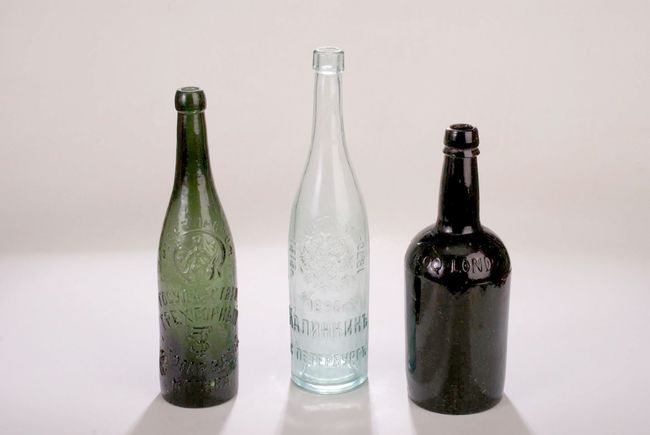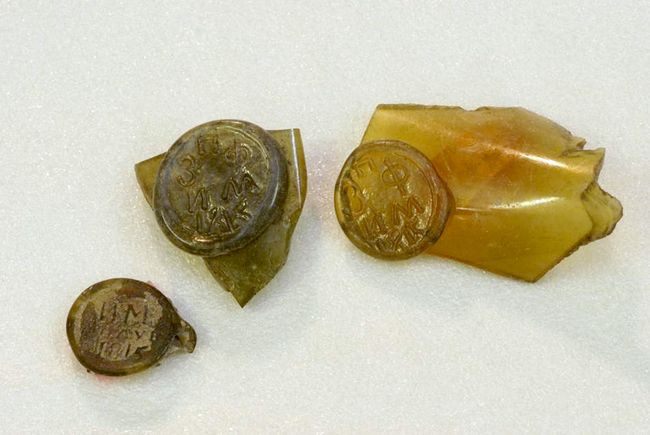A talk about bottles and glass flasks which were used by Kyivites of the 19th and early 20th century in their everyday life became the first event of 2017 for the project “LIKBEZ. The Historical Front.” Historians launched a lecture cycle at the National Museum of History of Ukraine, which involves talks about the past which are accessible and understandable for the average listener and promote interest in the study of history.
Candidate of Sciences in History Serhii Taranenko has been excavating sites in the capital for a number of years. He worked for the Podil Archaeological Expedition, later renamed the Center of Kyiv Archaeology, for a long time. Glass finds attracted his interest accidentally, but have been a focus of his work ever since.
According to Taranenko, excavations in the Ancient Kyiv Reserve are usually done as part of rescue archaeology. This means that developers have a duty to let archaeologists check on the site before construction starts, but this is not always the case. Sometimes they have to work barely avoiding accidents with excavators, and it happens that experts are prevented from even getting on the construction site. In the part of Podil within the reserve’s limits, the top layer of soil, reaching down up to two meters, is known as perekop, or “dug-up,” and contains the remains of household items and construction waste, mainly dating to the 19th century. It was there that the expedition’s members found various bottles and glasses.
Such traces of economic activity are usually not considered archaeological material. However, Taranenko was prompted by his senior colleague Viktor Tymoshchuk to take interest in these finds and began to collect them. When the collection reached a few hundred items by the early 2000s, he began to “dig up” information about them, and found only monographs on Ukrainian art glass and blown glass industry and several articles. “That is, such mass of sources was effectively absent from scholarship. Even when blown glass was the subject of research, bottles of the 19th and 20th centuries did not attract attention because people saw and used them, then lost interest and confined them to attics. But if one studies a lot of them, they can act as a source,” Taranenko told us.
A DOSE OF HEALTH
Glass bottles in Europe, including the Ukrainian lands, were used since the 15th century as containers not only for alcoholic drinks, but a variety of oils, vinegar, sauces, marinades, medicines, and loose products such as tobacco or poppy as well. Still, pharmaceutical containers have been the most frequent finds for Podil archaeologists. The earliest item dates back to the mid-18th century, but official written sources say that such containers were produced in Ukraine as far back as the 17th century.

The first Podil pharmacy opened its doors in 1730. By the mid-19th century, several prominent businessmen opened their own establishments. At the turn of the 20th century, Kyiv could even boast of a network of free pharmacies where people were getting prescription drugs. Accordingly, the volume of required glassware increased, and branded pharmaceutical bottles with inscriptions appeared. The most popular variety featured the emblem of the Russian Empire and the inscriptions “Pharmacy” [in Russian. – Ed.] and “Pharmacia,” and names of local pharmacies made an appearance as well.
Russian Imperial regulations for pharmacists specified not only the allowed designs of containers, but also which medicines belonged to which design. The appearance had to reflect the content, and pharmacists were to avoid any excesses in choosing the containers. Vials came in various sizes, their volume determined in ounces and marked on the bottom.
A SHELL FOR FLAVOR
In the early 20th century, the Russian Empire had 234 glass factories in operation, of which 15 were producing only small bottles for perfumes. The market leadership was contested by two industrialists: Alphonse Ralle and Henri Brocard. Their factories were not inferior to foreign competitors on the product range, offering almost 700 products to customers. Perfumes were not too expensive. Kyivites bought domestic products at about 4 rubles per bottle, and European ones at about 15 rubles.
In this market, the container’s shape is particularly important, so sometimes these products look like artistic masterpieces. But the plants did not produce glass bottles for individual firms. Perfumers had to choose from catalogs of universal models. However, there were exceptions made according to designs created by artists who worked for the plants. In the 20th century, design of vials was sometimes influenced by modernist trends and done by well-known jewelers, including the House of Faberge.

The collection also contains a Soviet-era item, which is a bottle labeled “ТЭЖЭ.” When decoded, the meaning of the label is rather prosaic: it stands for “the Fluid Concern,” the company that later became the main perfume producer in the Soviet Union. Not surprisingly, people tried to make the acronym sound better by decoding it in new ways (e.g., “a woman’s body”) or treated it like a French name “Tege,” similar to those of pre-revolutionary perfumers.
ALCOHOL AND GAS
Bottles for alcoholic drinks have been much rarer finds for archaeologists. In the 18th century, liquors were consumed mostly in taverns and other trading establishments. Only the urban elite could afford to drink wine at home celebrations or receptions. Average burghers typically consumed vodka or (weaker) brandy.
Intellectuals, who communicated with foreigners and were invited to receptions at their homes, gradually got used to quality wines and treated domestic products with contempt. Therefore, production of wine bottles was far less profitable than production of medicine or perfume containers.
Such bottles were usually branded. First branded glass bottles appeared in Britain in 1650. Over 200 brands came to be used in the Russian Empire. Not all of them have been deciphered, but some do provide information about the year of production, the volume of the bottle and the name of the owner of the plant or distillery.
Beer consumption was somewhat different. First bottled beer was produced during the reign of Catherine II. About 30 breweries operated in Kyiv in the late 19th century. These drinks were served at beer stalls with salty bagels, shrimp or crayfish for 5 kopecks a bottle. Better-quality drinks could be purchased for 12 kopecks. The affordability of non-local varieties of beer for the townspeople is evidenced by bottles from Moscow, St. Petersburg, and Estonia which have been found during excavations.
Attempts at deception and counterfeiting existed in those bygone days as well. For example, either a parody or a poor imitation of a London gin bottle was found, labeled with the inscription “Oldoli.” Often enough, counterfeiters copied not only the name, but also the appearance of the bottles. Some manufacturers, however, tried to protect their products. For example, the Benedictine liqueur had a set of marks on the bottle without which the product could not be considered authentic. Attempts at counterfeiting it still continued, and it is unclear whether the Kyivites knew at the time how to distinguish between the genuine drink and its counterfeited substitute.
Dishonest innkeepers (and not only in Ukraine, but also throughout Europe) used false-bottomed bottles. Outwardly, they looked standard, but a concave bottom discreetly reduced the volume and allowed the seller to deceive inattentive or drunk customers.
Mineral water won great popularity with the Kyivites in the 19th century. Accordingly, the number of containers for it grew. Typically, these bottles were labeled with the name of the beverage’s producer. Seltzer water (which had natural carbon dioxide in it) and soda water (with artificial gas) were both in high demand. Kyiv could boast of its own famous producer. Eduard Nemetti built a mineral water plant in Andriivsky Descent and produced 870,000 bottles a year. Judging by the production volumes, he sold them not only in Kyiv, but also in other cities of the empire, perhaps even abroad.
SHOES FOR VARNISHES
The combination of functionality and aesthetics extended to containers for technical substances as well. The Singer firm label could be seen not only on its sewing machines, but vials of oil for them as well. Glass shoe-shaped containers were used for leather softeners, necessary when breaking-in a new pair of shoes. This packaging was also used for varnishes, paints, oils, and inks...
Thus, glassware became an integral part of the Kyivites’ everyday life in the 19th century. The townspeople were increasingly well-educated, their incomes grew, so they began to care more about their health, appearance, and household items. Plastic did not yet exist, so glass containers had become indispensable for storage of a broad spectrum of substances. Due to it, Taranenko believes that his collection of bottles is a quite informative source about the living conditions of the Kyivites in that period. He donated bottles to the museums of the Kyiv Center of Archaeology, Hrinchenko University, the Kochubei Historical and Cultural Center, and still has a lot left. Therefore, the archaeologist is ready to share these items with other museum workers.








